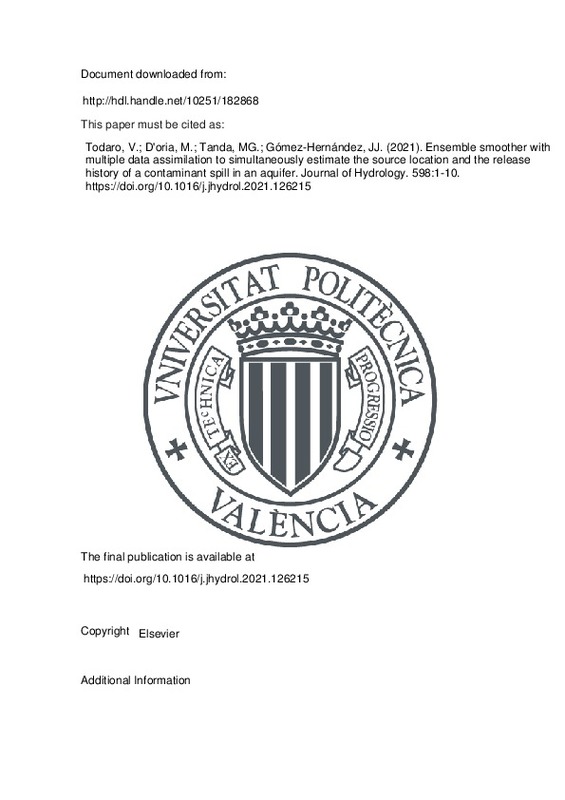JavaScript is disabled for your browser. Some features of this site may not work without it.
Buscar en RiuNet
Listar
Mi cuenta
Estadísticas
Ayuda RiuNet
Admin. UPV
Ensemble smoother with multiple data assimilation to simultaneously estimate the source location and the release history of a contaminant spill in an aquifer
Mostrar el registro sencillo del ítem
Ficheros en el ítem
| dc.contributor.author | Todaro, Valeria
|
es_ES |
| dc.contributor.author | D'Oria, Marco
|
es_ES |
| dc.contributor.author | Tanda, Maria Giovanna
|
es_ES |
| dc.contributor.author | Gómez-Hernández, J. Jaime
|
es_ES |
| dc.date.accessioned | 2022-05-24T18:04:56Z | |
| dc.date.available | 2022-05-24T18:04:56Z | |
| dc.date.issued | 2021-07 | es_ES |
| dc.identifier.issn | 0022-1694 | es_ES |
| dc.identifier.uri | http://hdl.handle.net/10251/182868 | |
| dc.description.abstract | [EN] The source location and the time history of a pollutant released in an aquifer are very relevant information for the design of effective remediation strategies. Usually, their identification requires solving an inverse problem when the only available information about the groundwater contamination event is a sparse set of concentration data collected in the aquifer at a few points downstream from the source. Here, a novel approach is proposed to solve the inverse problem: the use of the Ensemble Smoother with Multiple Data Assimilation (ES-MDA) in the context of source contamination identification. This method is used for the simultaneous determination of the time history and the source location of a pollutant release based on observed concentration data and a calibrated numerical model of groundwater flow and mass transport in the aquifer. The ES-MDA is demonstrated in two case studies. The first one is based on an analytical solution of the flow and transport equations, aimed at the estimation of the source location and the release history of a nonreactive pollutant spreading in a two-dimensional homogeneous aquifer from a point source. For this case, different alternatives are considered for the spatial distribution of the observation points, the concentration sampling frequency, the ensemble size and the use of covariance localization and covariance inflation techniques in the formulation of the smoother. The purpose of this case is to test the new approach, analyze its performance and also to identify the conditions that render the problem ill-posed and, therefore, without solution; also, in this case, a new spatiotemporal iterative localization is presented. In the second case study, we use real data collected in a laboratory sandbox that reproduces a vertical cross-section of an unconfined aquifer with two-dimensional quasi-parallel flow between constant-head boundaries. The results show that the location, time and number of observations, the ensemble size and the application of covariance localization and covariance inflation techniques have an impact on the final solution. A well-designed monitoring network and the application of covariance corrections improve the performance of the ES-MDA and help avoiding ill-posedness and equifinality. The application to laboratory data validates the potential of ES-MDA to simultaneously estimate the time history and the source location of a pollutant released in groundwater in real cases. | es_ES |
| dc.description.sponsorship | The TeachinParma initiative, co-funded by Fondazione Cariparma and University of Parma (http://www.teachinparma.com/about/) supported Prof. J. Jaime Gomez-Hernandez as Visiting Professor at the University of Parma. Project PID2019-109131RB-I00 financed by the Spanish Ministry of Science and Innovation is also gratefully acknowledged | es_ES |
| dc.language | Inglés | es_ES |
| dc.publisher | Elsevier | es_ES |
| dc.relation.ispartof | Journal of Hydrology | es_ES |
| dc.rights | Reconocimiento - No comercial - Sin obra derivada (by-nc-nd) | es_ES |
| dc.subject | Inverse modeling | es_ES |
| dc.subject | Ensemble Kalman filter method | es_ES |
| dc.subject | Groundwater contaminant source | es_ES |
| dc.subject | Covariance localization | es_ES |
| dc.subject | Stochastic analysis | es_ES |
| dc.subject.classification | INGENIERIA HIDRAULICA | es_ES |
| dc.title | Ensemble smoother with multiple data assimilation to simultaneously estimate the source location and the release history of a contaminant spill in an aquifer | es_ES |
| dc.type | Artículo | es_ES |
| dc.identifier.doi | 10.1016/j.jhydrol.2021.126215 | es_ES |
| dc.relation.projectID | info:eu-repo/grantAgreement/AEI/Plan Estatal de Investigación Científica y Técnica y de Innovación 2017-2020/PID2019-109131RB-I00/ES/APRENDIZAJE AUTOMATICO PARA HIDROGEOLOGOS FORENSES/ | es_ES |
| dc.rights.accessRights | Abierto | es_ES |
| dc.contributor.affiliation | Universitat Politècnica de València. Departamento de Ingeniería Hidráulica y Medio Ambiente - Departament d'Enginyeria Hidràulica i Medi Ambient | es_ES |
| dc.description.bibliographicCitation | Todaro, V.; D'oria, M.; Tanda, MG.; Gómez-Hernández, JJ. (2021). Ensemble smoother with multiple data assimilation to simultaneously estimate the source location and the release history of a contaminant spill in an aquifer. Journal of Hydrology. 598:1-10. https://doi.org/10.1016/j.jhydrol.2021.126215 | es_ES |
| dc.description.accrualMethod | S | es_ES |
| dc.relation.publisherversion | https://doi.org/10.1016/j.jhydrol.2021.126215 | es_ES |
| dc.description.upvformatpinicio | 1 | es_ES |
| dc.description.upvformatpfin | 10 | es_ES |
| dc.type.version | info:eu-repo/semantics/publishedVersion | es_ES |
| dc.description.volume | 598 | es_ES |
| dc.relation.pasarela | S\437988 | es_ES |
| dc.contributor.funder | AGENCIA ESTATAL DE INVESTIGACION | es_ES |







![[Cerrado]](/themes/UPV/images/candado.png)

